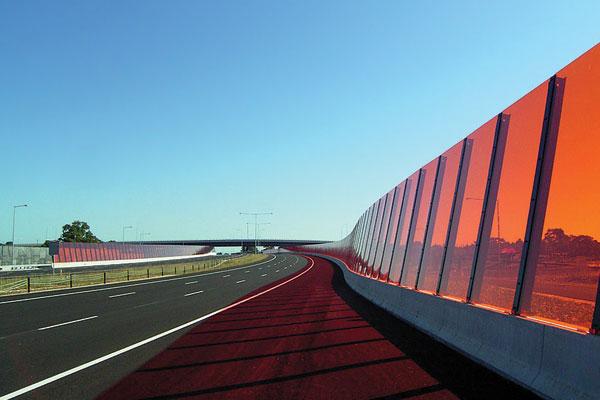Singapore’s skyline never stops growing. With limited land and dense urban environments, construction sites often operate within metres of homes, offices, schools, and hospitals. The problem is that sound travels easily through concrete corridors and narrow streets.
Even moderate construction noise can disrupt daily life or violate NEA (National Environment Agency) limits. Once complaints start rolling in, contractors may face restricted working hours, investigations, or even stop-work orders. Each delay adds costs and frustration.
What a Sound Barrier Really Does
Sound barriers that sites use today is typically a flexible, high-density material designed to absorb and block sound waves. It acts as a protective wall that keeps noise from spreading into the surrounding area.
These barriers can be mounted on scaffolding, fences, or custom frames. They’re built from weather-resistant materials that withstand Singapore’s humidity and heavy rain, while still being light enough for quick installation and reuse.
Why Developers See Them as a Smart Investment
Sound barriers aren’t the most exciting line item on a project budget. But their impact goes far beyond what they cost.
In Singapore’s tightly regulated environment, projects that actively manage their noise are more likely to get faster approval from local authorities and less pushback from the public. That means fewer disruptions, fewer fines, and a cleaner track record for future bids.
Developers who invest in effective sound barrier systems often find that their projects finish on time and with fewer headaches. It’s a small investment that pays off in saved time, stronger reputation, and smoother operations.
Protecting Relationships With the Community
Every construction site affects its surroundings, especially in high-density areas like Tiong Bahru, Queenstown, or Paya Lebar. Residents are more vocal about disruptions, and community trust can make or break a project’s public image.
Installing proper sound barriers in Singapore demonstrates responsibility. It sends a message that the project cares about its neighbours and the local environment.
When people feel considered, they’re more likely to stay cooperative. And when the NEA sees proactive noise management, they’re less likely to intervene.
Cutting Down Delays and Costs
Every delay has a price. Extended equipment rental, rebooked subcontractors, additional permits — they all add up quickly. Noise complaints are one of those hidden triggers that can derail even well-planned schedules.
Sound barriers prevent that chain reaction. By keeping noise within legal limits, they reduce the risk of enforced downtime or shortened working hours. That consistency keeps manpower productive and machinery running when it should.
In the long run, a one-time investment in barriers can save far more than what it costs to handle repeated complaints or rework timelines.
Safer and More Focused Worksites
Noise doesn’t just disturb the public; it also affects the people working on site. Constant loud sounds make communication difficult and can cause fatigue or errors.
With sound barrier contractors use around noisy machinery or perimeter zones, the difference is noticeable. Workers can hear instructions more clearly, concentrate better, and move around safely without shouting to be heard.
A calmer environment isn’t only more pleasant — it’s more productive.
Meeting Sustainability and CSR Expectations
Singapore’s construction industry is steadily moving towards greener and more socially responsible practices. The push for sustainable, community-conscious building means that noise management now sits alongside dust control and waste reduction as a key performance measure.
Using reusable sound barrier products aligns perfectly with that shift. Many barriers are designed to last through multiple projects, reducing material waste. They can even be recycled at end of life, supporting corporate sustainability goals while maintaining compliance.
From Compliance to Competitive Advantage
In a city where construction projects are often publicly visible, reputation matters. Developers who run well-organised sites gain a clear advantage when bidding for future work.
Authorities appreciate projects that operate responsibly, clients appreciate fewer delays, and residents appreciate being able to live in peace while progress continues. All of that builds credibility, something that’s hard to buy and easy to lose.
Sound barriers today aren’t just a tool for compliance. It’s a statement about professionalism, foresight, and care for the community.
Real Example: How One Project Turned Complaints Into Compliments
A mid-sized contractor working on a mixed-use project in Toa Payoh faced growing complaints during piling works. Instead of reducing hours, the team installed modular sound barriers around the site and near noisy machinery.
Noise levels dropped immediately, allowing full working days to continue without breaching NEA limits. The nearby residents noticed the difference — complaints stopped, and one even sent a note thanking the team for taking action.
The project stayed on track and finished two weeks ahead of schedule. All because of a simple decision to invest in better noise control.
The Bigger Picture
In the rush to meet deadlines, it’s easy to overlook how something as simple as sound management shapes the success of a project. But in Singapore’s dense and closely watched construction environment, it’s often the noise-mitigated sites that make the loudest impression.
When you think of sound barriers not as an expense but as a smart safeguard for your budget, timeline, and reputation, the benefits become obvious.
Investing in a quality sound barrier solution gives you more than compliance — it gives you peace of mind, smoother approvals, and a site that runs confidently from start to finish.










